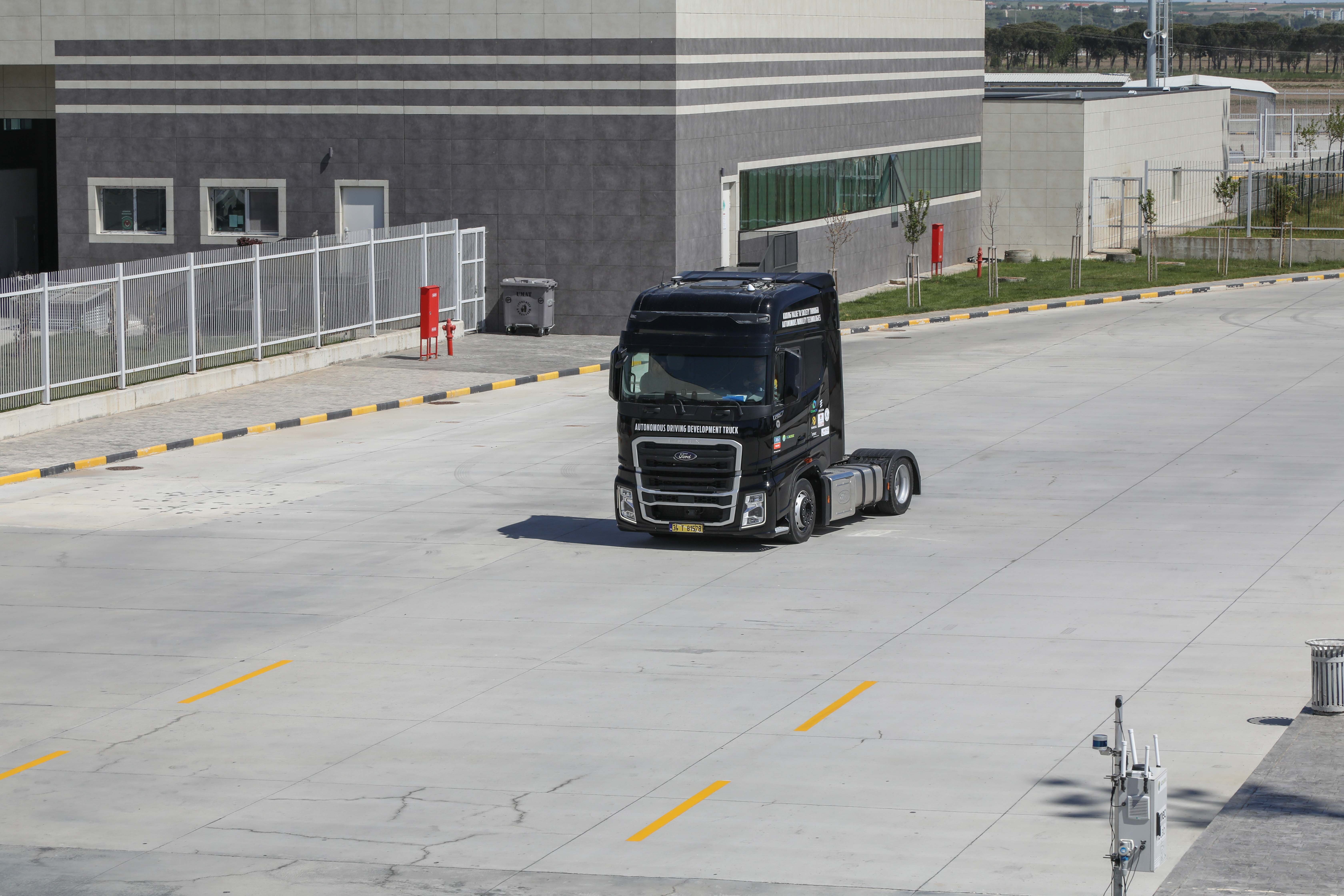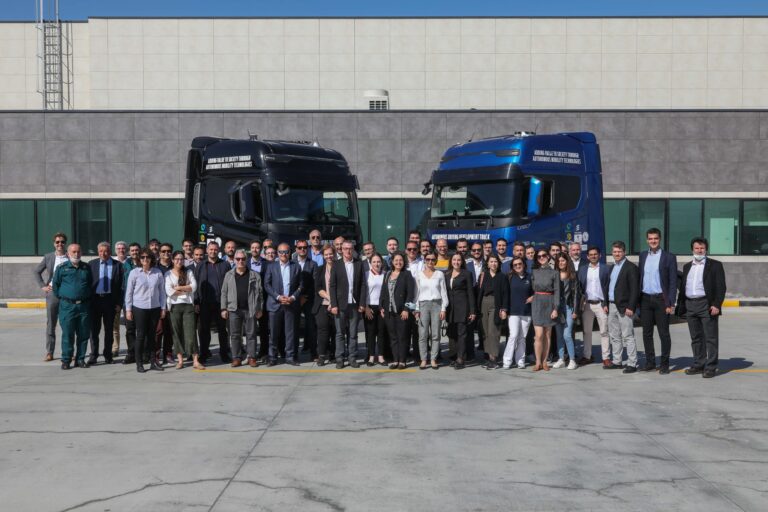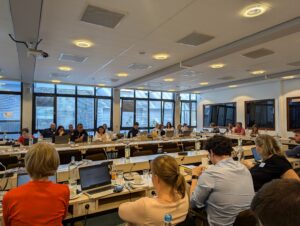On 10 May, in the presence of European Commission officials and other high-ranking representatives from the Greek and Turkish political and business worlds, a public demo event was held at the Greek-Turkish cross-border road bridge of Evros between the towns of Kipoi and Ipsala. The demonstration included two Ford F-Max trucks crossing the border freely, without stopping for manual control and without the slightest input from the drivers.
The partners involved in the Greek-Turkish cross-border corridor demonstrated live four innovative pioneering automated driving functions, and two scenarios of assisted border crossing at the Greek and Turkish customs areas respectively:
- truck platooning between the borders with uninterrupted 5G coverage from two national telecommunication networks across a “hard border”;
- remote control and risk forecasting via sensors upon arrival of the truck near the border crossing;
- the autonomous routing of the truck during the customs control crossing.
During the handover between the neighbouring, national mobile networks COSMOTE & Turkcell, event attendees witnessed a live broadcast of an uninterrupted “See-What-I-See” application, one that enables the exchange of live video stream between the vehicles of a truck platoon. Participants from both inside and outside the 5G-MOBIX consortium had the opportunity to sit next to the truck driver and experience first-hand the possibilities that 5G-enabled CAM applications offer the transportation industry.
User stories test border-crossing, truck routing and platooning
These use case trials, including streamlined border crossings aim to foster faster and safer transactions within the customs area to prevent long queues and to help decrease fuel consumption.
The assisted border-crossing use case focuses on remote vehicle inspection and predictive risk assessment for all trucks coming into the customs area at the GR-TR cross-border site. Using a smartphone application, the VRU and False License Plate scenarios were tested. In the VRU case, as the truck approaches the border crossing and the distance between the truck and the smartphone is reduced, the VRU protocol gets activated, and the truck stops autonomously before an accident occurs with the customs agent. False license plate detection works by scanning the license plate of the truck as it approaches the customs area. If a false plate is detected, a message appears on the application that the truck is not authorized to continue, the traffic light turns red, and the truck is ordered to stop.
The autonomous truck routing scenario inside the customs area was demonstrated in two iterations: driving from start to finish on an obstacle-free road and ensuring the truck stops when encountering an obstacle on the road.

Partner connections make demo event a success
Many external stakeholders and 5G-MOBIX consortium members came together to organise the event where different user cases were successfully tested and demonstrated. The 5G networks used during the trials and demonstrations were provided by ERICSSON Greece and ERICSSON Turkey. ERICSSON’s expertise in the field of connectivity and services in the automotive and transport industries was crucial for the successful outcome of the tests. Utilizing its extensive experience in the installation and operation of 5G networks around the world, ERICSSON has developed and provided innovative 5G technologies that promote cooperative and automated transport services on national and cross-border road networks.
For the purposes of the project, ERICSSON has developed an independent 5G pillar network which, in cooperation with the 5G peer network implemented by Turkcell, has been configured to support advanced handover and roaming. COSMOTE and Turkcell, on the other hand, have both provided existing infrastructure and networks to cover this cross-border corridor. As the corridor leader in the project, Turkcell has provided the cloud integration of certain applications, as well as the 5G test infrastructure established along the way.
The Turkish vehicle manufacturer Ford Otosan provided the two F-MAX trucks to carry out the defined user stories. Each truck is equipped with On Board Units (OBU) supplied by OBU developers WINGS and IMEC, who provided their expertise and solutions to support the trials. Wings ICT Solutions helped achieve the Kipi cross-border station demonstration by developing and testing an innovative 5G-enabled assisted “zero-touch” border crossing service for vehicles. Through 5G real-time connectivity, the OBU can communicate with the peripheral Road Side Unit (RSU), also developed by WINGS, and collect and send large amounts of data from the vehicle to the WINGS smart platform. As a result, customs control procedures are significantly accelerated; staff and border security are enhanced and an automated vehicle can cross the border without having to stop for on-site manual control.
The research team ISENSE Group of the University Research Institute of Communication and Computer Systems (EPISEV), in collaboration with the National Technical University of Athens (NTUA), have contributed to the trials with the “See-What-I-See” CAM application, and are also coordinating the evaluation efforts across the project.
TIR routing algorithms for autonomous driving and object detection algorithms used within the scope of the project were developed by TÜBİTAK BİLGEM in order to prevent possible accidents; and BİLGEM cloud technologies platform Safir Bulut has enabled autonomous driving by running the developed algorithms from the Gebze campus, 400 km away from the vehicle.
The GR-TR cross-border-trial event illustrated in concrete terms the added value to transportation systems when vehicles have uninterrupted 5G coverage from the national telecommunications networks. The low latency and high bandwidth provided by 5G technology, and the capabilities offered by advanced artificial intelligence technologies, provide a faster response to safer and autonomous driving. The technologies developed through the project allow the smooth passage of interconnected automated trucks at border crossings with particular difficulties – long queues, long waits and delays at border stations.
5G-MOBIX thus contributes to, safer driving and the reduction of the environmental footprint of road transport, but also to the upgrading of international road networks in order to accommodate intelligent vehicles.
Further information
You can rewatch the live broadcast from Greek TV below:
and video in Turkish from Tubitak about the demo below:
You can find all the press clippings here.
You can view more photos from the demo day here.







